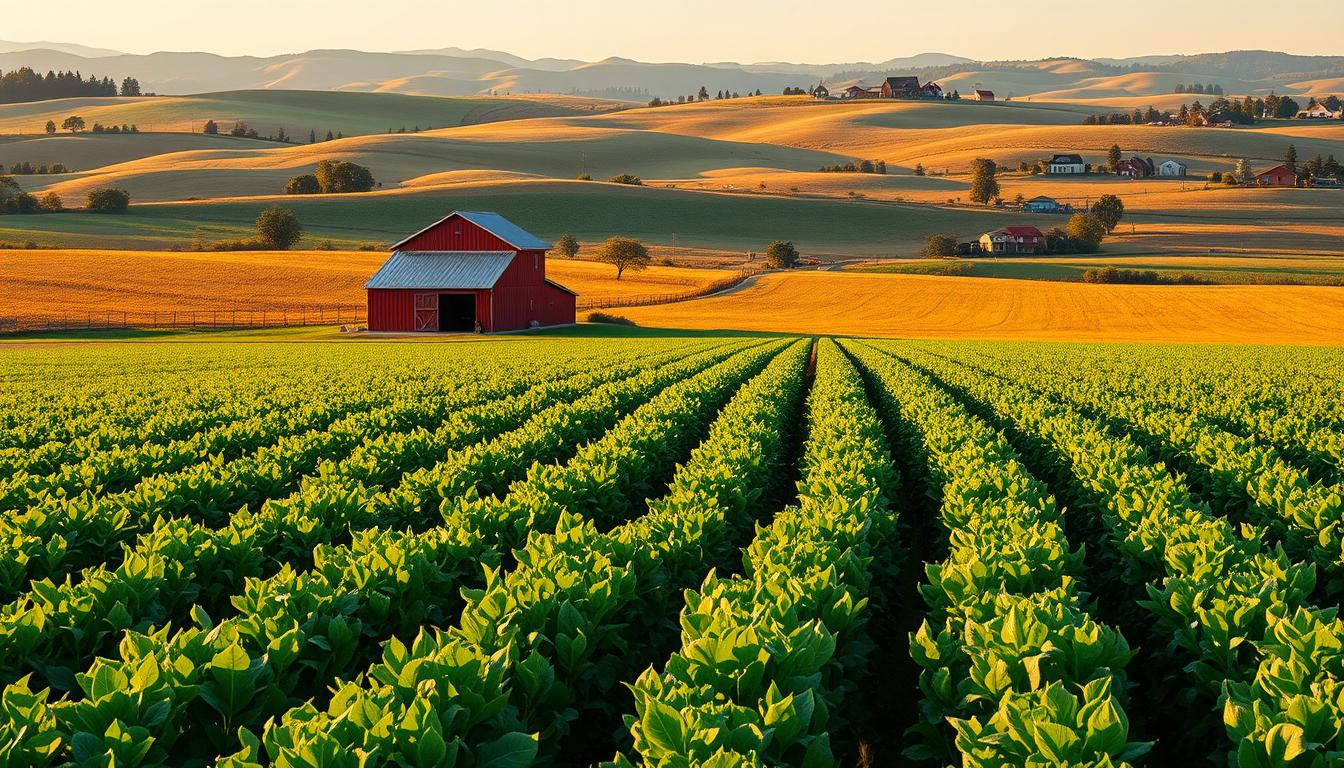Farmland offers a unique way to diversify your portfolio. With an average value of $4,080 per acre in 2023, it provides steady returns. Over the past two decades, farmland outperformed the S&P 500, delivering 12.75% annual gains.
Modern platforms have made it easier than ever to get started. Instead of buying hundreds of acres, you can begin with smaller amounts. Some services allow entry for as low as $15,000, opening doors for new investors.
Celebrities and seasoned investors are turning to this asset class. With nearly 40% of U.S. farmland leased to farmers, passive income is a key benefit. This guide explores five simple ways to enter this growing market.
Key Takeaways
- Farmland has historically outperformed the stock market.
- New platforms lower the barrier to entry for beginners.
- Leasing options provide steady passive income.
- Average farm values continue to rise nationwide.
- Multiple methods exist beyond direct ownership.
Why Farmland Is a Smart Investment for Beginners
Farmland isn’t just dirt—it’s a resilient asset class with dual income potential. Over 29 years, U.S. cropland delivered 12.75% average annual returns, beating the S&P 500. Even during the 2008 crash, values dipped only 11% while stocks plummeted 50%.
Historical Performance and Stability
The NCREIF Farmland Index shows steady growth. In 2022, values rose 10.2% as stocks fell 20%. Iowa’s 40-year data reveals returns of 8.8% yearly—6.7% from appreciation and 6.1% from rents.
Key advantages:
- Recession-proof: 11% max decline vs. 50%+ for stocks.
- Dual income: 5–7% rental yields plus 3–5% appreciation.
- Low correlation (0.3) to stocks for better diversification.
Farmland vs. Traditional Assets
Unlike stocks, farmland thrives during inflation. It’s a tangible asset with intrinsic value. Compare key metrics:
| Metric | Farmland | S&P 500 | Bonds |
|---|---|---|---|
| Avg. Annual Return (1993–2022) | 12.75% | 10.67% | 4.91% |
| 2008 Crisis Decline | 11% | 50%+ | 5% |
| Liquidity | 4-month sale | Instant | 1–3 days |
| Inflation Hedge | Strong | Moderate | Weak |
Farmland’s slow turnover (4-month sales) reduces volatility. It’s ideal for long-term builders of wealth.
How to Invest in Farmland: 5 Beginner-Friendly Methods
Real estate investment in rural areas offers unique financial benefits. From direct ownership to fractional shares, there’s a method for every budget. Below, we break down five accessible approaches.
1. Direct Ownership: Buying and Leasing Land
Purchasing land outright costs an average of $1.9 million. Leasing to farmers can yield 5–7% annual returns. However, maintenance and equipment expenses add complexity.
2. Farmland REITs (Real Estate Investment Trusts)
REITs like Gladstone Land (LAND) let you invest without managing properties. They must distribute 90% of income as dividends, creating *steady income*. Farmland Partners (FPI) is another top pick.
3. Agricultural Stocks and ETFs
Companies like Archer-Daniels-Midland (ADM) tie to crop production. ETFs bundle multiple stocks, reducing risk. The VanEck Agribusiness ETF (MOO) includes Deere & Co. (DE) and Corteva.
4. Farmland Crowdfunding Platforms
Platforms lower entry costs significantly:
| Platform | Minimum | Fees |
|---|---|---|
| AcreTrader | $15,000 | 0.75%–1% |
| FarmTogether | $15,000 | 1% management fee |
| Farmfundr | $10,000 | 2% acquisition fee |
5. Mutual Funds Focused on Agriculture
The Fidelity Agricultural Productivity Fund (FARMX) blends stocks and real estate. Mutual funds offer diversification, ideal for beginners. Annual returns average 8–10% over a decade.
Each strategy balances risk and reward. Crowdfunding suits smaller budgets, while REITs provide liquidity. Choose based on your goals.
Pros and Cons of Farmland Investing
Owning a piece of land comes with unique financial perks and hurdles. While values often rise during inflation, locking in profits takes time. Below, we break down the key trade-offs.
Advantages: Inflation Hedge, Diversification, Steady Income
Farmland thrives when prices climb. In 2022, values jumped 10.2%—outpacing the 9.1% CPI surge. Since 1991, returns doubled inflation levels.
Other advantages include:
- Diversification: Low correlation (0.3) to stocks buffers market swings.
- Steady income: Iowa leases average $200/acre yearly—triple residential cap rates.
- Passive ownership: 80% of leased land is managed by non-farmers, per USDA.
Challenges: Liquidity, Upfront Costs, Management Complexity
Selling land takes ~4 months, unlike stocks. Crowdfunding platforms like AcreTrader enforce 3–5-year lockups. REITs offer daily liquidity but lack direct ownership perks.
Hidden costs add up:
| Platform | Minimum Capital | Management Fees |
|---|---|---|
| FarmTogether | $15,000 | 1% yearly |
| Farmfundr | $10,000 | 2% upfront + 15% profit share |
Full-service firms like Weiland Farms simplify management for a fee. Weigh these challenges against long-term gains.
Understanding Farmland Returns: Income and Appreciation
Farmland returns come from two key sources: steady income and long-term appreciation. Over 20 years, this combo delivered 12.75% average annual returns, per AcreTrader data. Let’s break down how each component works.

Rental Yields vs. Land Value Growth
Iowa State data shows a 6.1% average cash rent yield plus 2.7% real appreciation. The NCREIF Farmland Index reveals a 75:25 split—most gains come from rising land prices.
Crop types behave differently:
- Row crops (corn, soybeans): Stable rents, slower appreciation.
- Permanent crops (almonds, vineyards): Higher volatility but premium prices.
| Crop Type | Avg. Rental Yield | Appreciation (2010–2023) |
|---|---|---|
| Corn (Iowa) | 5.8% | 73% ($7,500 → $13,000/acre) |
| Almonds (California) | 4.2% | 112% |
Case Study: U.S. Farmland Returns (2002–2022)
In 2022, land values jumped 10.2% amid 9.1% inflation—proof of its hedge power. A $500,000 investment at 8% return would grow to $734,000 in 5 years, with less volatility than stocks.
“Farmland’s dual-income model—rents plus appreciation—makes it a rare asset. Even in downturns, people still eat.”
Key Trends Shaping Farmland Investments
Global shifts are transforming rural assets into high-value opportunities. From tech-driven production boosts to sustainable practices, these forces redefine land’s potential. Understanding them helps craft a winning strategy.
Population Growth and Rising Food Demand
The UN projects 9.7 billion people by 2050, requiring 60% more food. China’s soybean imports now exceed 50%, reflecting global supply gaps. Urbanization claims 1.5% of arable land yearly, squeezing production.
Technology and Sustainable Farming Practices
Precision tools like soil sensors boost yields by 20%. California’s water laws highlight resource scarcity challenges. Regenerative farms command 30% premiums for carbon capture—a market edge.
Global Opportunities (Emerging Markets vs. U.S.)
Brazil’s farmland appreciates at 12% annually, outpacing U.S. stability. Research underscores regional risks: water rights in Arizona versus Chile’s drought resilience. Diversification is key.
“The next decade belongs to tech-savvy, sustainable land stewards.”
From drones to drought-resistant crops, innovation drives this asset class. A forward-looking strategy balances global trends with local realities.
Choosing the Right Farmland Investment Strategy
Selecting the ideal farmland approach requires matching land types to financial goals. Whether you prioritize steady income or long-term growth, understanding crop differences and geographic trends is key.
Assessing Your Risk Tolerance and Goals
Farmland isn’t one-size-fits-all. If you prefer stability, row crops like corn offer predictable returns. For higher gains, permanent crops like almonds yield 9–12% but require patience—orchards take 3–7 years to mature.
Key factors to weigh:
- Risk tolerance: Citrus swings 15% yearly vs. 5% for soybeans.
- Timelines: Almonds need years; row crops pay faster.
- Portfolio balance: Mix both for diversification.
Row Crops vs. Permanent Crops: What’s Best for You?
Iowa’s cornfields and California vineyards highlight regional strengths. Row crops thrive with rotation, boosting yields 10–15%. Permanent types lock value in trees—40–70% of their worth.
| Crop Type | Avg. Return | Volatility |
|---|---|---|
| Corn/Soybeans | 6–8% | Low (5%) |
| Almonds/Vineyards | 9–12% | High (15%) |
“Organic transitions add 20% premiums—niche opportunities reward innovation.”
REITs and funds simplify access. Your portfolio should reflect both appetite for risk and patience for growth.
Due Diligence: What to Look for Before Investing
Smart investors know due diligence separates winners from costly mistakes. Whether you’re eyeing row crops or vineyards, three pillars ensure success: location, legal safeguards, and trusted partners. Skip these steps, and even fertile land can turn into a money pit.
Location Factors: Soil Quality and Water Access
Soil maps reveal more than dirt—they predict profits. The USDA’s Web Soil Survey rates land for crop suitability. Iowa’s cornfields, for example, need a minimum 80/100 score for optimal yields.
Water rights vary wildly by state:
| State | Water Rights System | Key Consideration |
|---|---|---|
| California | Prior Appropriation | Seniority matters during droughts |
| Texas | Riparian | Access tied to property lines |
“Our six-generation farm thrives because we test soil annually and secure water rights first.” — Weiland Farms, Iowa
Legal and Regulatory Considerations
Title searches uncover hidden risks like easements or mineral rights disputes. A 104-acre athlete-owned farm in Nebraska lost 15% value due to undisclosed zoning restrictions.
Essential checks:
- Estate liens: Unpaid taxes can transfer to new owners.
- Crop share leases: Verify if they override cash rent agreements.
Partnering with Farmers or Land Managers
Passive investors rely on operators. Ask these 10 questions before committing capital:
- What’s your crop rotation history?
- How do you handle pest outbreaks?
Weiland Farms’ management team, for instance, uses satellite tech to monitor fields—proving expertise pays.
Conclusion
Diversifying your portfolio with rural assets offers stability and growth potential. Whether through REITs, crowdfunding, or direct ownership, each method suits different goals and budgets.
For optimal results, consider a long-term investment horizon—10+ years lets compounding work its magic. Experts recommend allocating 5-15% of your holdings to balance risk and reward.
Before committing, leverage tools like the USDA’s agricultural statistics for data-driven decisions. Ready to start? Download our free checklist to streamline your research process.
With the right strategy, agriculture can become a cornerstone of your wealth-building journey.
FAQ
What makes farmland a stable investment?
Farmland offers consistent returns due to steady demand for food production. Unlike volatile stocks, it provides long-term appreciation and rental income.
How does farmland compare to stocks and bonds?
Farmland has lower volatility than stocks and often outperforms bonds. It also acts as an inflation hedge, with land values rising alongside food prices.
Can I invest in farmland without buying land directly?
Yes! Options like REITs, crowdfunding platforms, and agricultural ETFs allow exposure without owning physical property.
What are the risks of farmland investing?
Challenges include high upfront costs, limited liquidity, and management demands. Weather risks and regulatory changes can also impact returns.
How do rental yields and land appreciation work?
Rental income comes from leasing to farmers, while appreciation reflects rising land values. U.S. farmland averaged 10% annual returns over 20 years.
What trends are driving farmland demand?
Population growth, tech advancements in farming, and global food shortages boost opportunities. Emerging markets offer high-growth potential.
Should I invest in row crops or permanent crops?
Row crops (corn, soybeans) offer flexibility, while permanent crops (orchards, vineyards) provide higher income but require longer commitments.
What due diligence is needed before investing?
Check soil quality, water rights, and local regulations. Partnering with experienced farmers or managers reduces operational risks.


